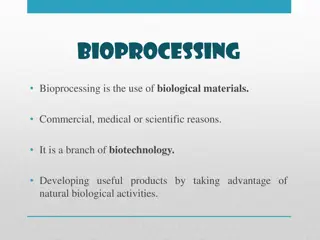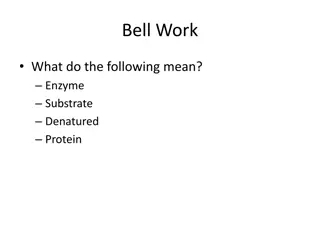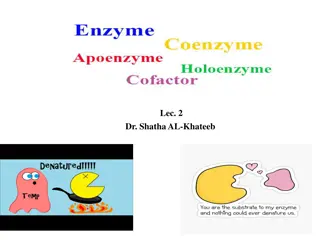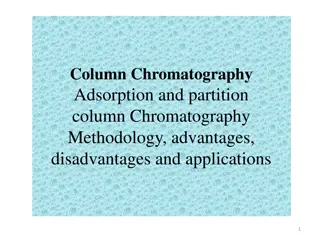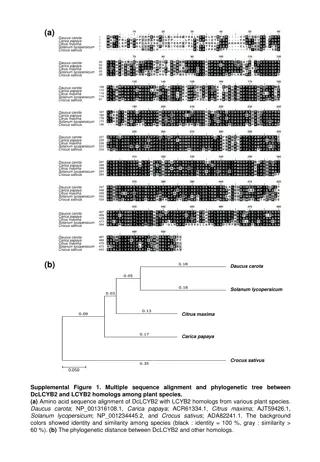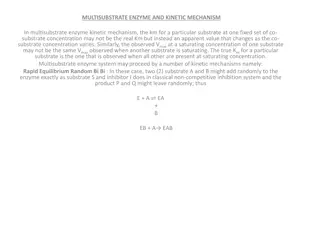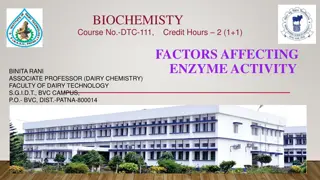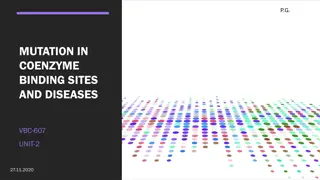mRNA Chromatography Applications: Resin Types and Purification Efficiency
This content delves into mRNA chromatography applications, focusing on the mRNA purification process using dT affinity chromatography, IEX, HIC, and RP techniques. It discusses the application of mRNA affinity resins like Monomix dT20 and Proteomix POR50-dT20, highlighting their properties, purifica
3 views • 8 slides
Enzymes are Proteins that act as Biological Catalyst
Enzymes, as proteins acting as biological catalysts, accelerate chemical reactions without being consumed. They have active sites where substrates bind, and their specificity can be lock-and-key or induced fit. Enzymes are named based on their function or the substrates they interact with. Enzyme sp
5 views • 20 slides
Understanding the Role of Phosphatase Enzymes in Metabolic Reactions
Phosphatase enzymes play a crucial role in various metabolic processes by releasing phosphate groups, increasing their availability for energy synthesis and cell structure formation. Acid phosphatases, with an optimum pH below 7.0, can be extracted from plant tissues like germinating mung beans. A p
7 views • 34 slides
Network Function Abstraction A delicate question of (CPU) affinity?
Exploring the delicate balance of CPU affinity in network function abstraction, including challenges, benefits, and solutions like CPU pinning for network workloads. Learn about the impact on performance and scalability, as well as the importance of proper configuration in virtual and physical envir
3 views • 40 slides
Understanding Enzyme Function Through Induced Fit Model
The learning content discusses enzymes as biological catalysts that increase reaction rates by lowering activation energy. It explores how enzyme activity efficiency is influenced by factors such as temperature, pH, and substrate concentration. The Induced Fit Model is analyzed to explain how enzyme
5 views • 12 slides
Phylogenetic Analysis of Enzyme Sequences in Plant Species
The content discusses the amino acid sequence alignment and phylogenetic tree analysis of enzyme sequences, specifically DcLCYB2, among different plant species including Daucus carota, Carica papaya, Citrus maxima, Solanum lycopersicum, and Crocus sativus. The study explores the genetic relationship
2 views • 5 slides
Understanding Bioprocessing: Advantages, History, Applications, and Enzyme Use
Bioprocessing utilizes biological materials for commercial, medical, and scientific purposes, leveraging natural biological activities to develop useful products. This branch of biotechnology offers advantages such as low temperature, pressure, and pH requirements, along with renewable resources for
1 views • 11 slides
Investigating the Impact of Pineapple Enzyme Bromelain on Gelatin and Pasteurization Process
Explore the effects of pineapple enzyme bromelain on gelatin and how pasteurization can alter its effectiveness in this lab experiment. Discover the different outcomes when using fresh versus canned pineapple and formulate hypotheses to guide the investigation. Follow step-by-step procedures to test
0 views • 15 slides
Factors Affecting Enzyme Activity and Catalysis
Enzyme activity is influenced by various factors such as enzyme concentration, temperature, pH, substrate concentration, inhibitors, activators, and physical agents. The rate of enzyme-catalyzed reactions is directly proportional to enzyme concentration, and temperature plays a significant role with
0 views • 23 slides
Understanding Enzyme Function: The Key Steps and Importance of Cofactors
Enzymes play a crucial role in catalyzing biochemical reactions by forming enzyme-substrate complexes and facilitating changes in substrate molecules to product molecules. The process involves four steps: proximity of enzyme and substrate, binding at the active site, catalysis leading to substrate a
0 views • 39 slides
Principles of Staining in Histopathologic Techniques
Beginning with an introduction to staining in biochemical techniques, this chapter delves into the types of stains, factors influencing selectivity, and commonly used stains in histopathology. Learning objectives include defining staining, discussing dye-tissue affinity, understanding selectivity fa
2 views • 107 slides
Understanding Peroxidase Enzyme Activity in Biological Samples
Demonstrating the enzyme activity of peroxidase, an enzyme that plays a crucial role in breaking down hydrogen peroxide in various organisms. Learn about the differences between peroxidase and catalase, the calculation of enzyme activity, and the significance of extinction coefficient in enzyme assa
0 views • 8 slides
Understanding Microbial Nutrition and Bacterial Physiology
Microbial nutrition involves essential elements required for microbial growth and energy production. Bacterial physiology delves into the structures and functions that enable bacteria to thrive, from cell wall composition to enzyme activities. Major elements like C, O, H, N, S, and P are crucial for
2 views • 20 slides
Understanding Column Chromatography: Methodology, Advantages, Disadvantages, and Applications
Column chromatography, a type of adsorption chromatography, involves separating components based on their affinity to an adsorbent. The methodology includes passing a solvent through a column to improve separation, obtaining a chromatogram, and eluting components for analysis. The principle relies o
2 views • 24 slides
Exploring Enzyme Kinetics for Understanding Chemical Reactions
Enzyme kinetics is a vital discipline focusing on the rate of enzyme-catalyzed reactions and how they respond to varying conditions. Reactions are classified based on reactant concentration influences. Zero, first, second, and third order reactions are distinguished, with examples like first-order r
0 views • 31 slides
Demonstration of Salivary Amylase Enzyme Action in B.Sc. Practical
Salivary amylase, an enzyme found in saliva, partially hydrolyzes starch into maltose. This practical involves observing the action of salivary amylase on starch, demonstrating how starch is broken down into glucose and maltose. The procedure includes preparing solutions, collecting saliva, mixing w
0 views • 5 slides
Affinity Care Lipid Pathway Summary and Assessment
The Affinity Care Lipid Pathway outlines a systematic approach to assessing lipid/cholesterol blood results in individuals over 16 years old. It includes guidelines for managing cholesterol levels, assessing familial hypercholesterolemia, and determining appropriate medication options based on indiv
0 views • 5 slides
Enzyme Immobilization: Techniques and Applications in Industry and Healthcare
Enzyme immobilization involves confining enzymes on inert supports for stability and reuse, enhancing efficiency and cost-effectiveness. Historical events and examples illustrate various methods and applications. Chemical modifications, such as PEG addition, have shown increased enzyme activity. The
0 views • 34 slides
Factors Affecting Enzyme Activity and Kinetics Experiments
Explore the factors influencing enzyme activity, such as substrate and enzyme concentration, temperature, pH, and inhibitors. Learn how to simulate enzyme kinetics using equipment like popping beads and stopwatches. Analyze results to understand the impact of substrate concentration on reaction rate
0 views • 22 slides
Understanding Enzyme Activity and Optimal Conditions
This interactive content provides a detailed exploration of enzyme activity through data interpretation and graph analysis. Questions range from identifying the impact of enzymes on specific molecules to determining optimal conditions for various enzyme functions such as pH and temperature. Users de
0 views • 16 slides
Immobilization of Enzymes in Biochemistry
Enzyme immobilization involves confining enzyme molecules to a distinct phase from substrates and products, attaching them to solid matrices for enhanced specificity and reduced inhibition. Inert polymers or inorganic materials are used as carrier matrices with methods like physical adsorption onto
0 views • 24 slides
Understanding Quantitative Aspects of Drug Action
Explore the quantitative aspects of drug action, including drug receptor binding, concentration binding curves, dose-response curves, and types of antagonism. Learn to relate drug concentration to receptor binding capacity and response produced. Discover how concentration binding curves and dose-res
0 views • 29 slides
Understanding Enzyme Inhibition in Biochemistry
Enzyme inhibition plays a crucial role in pharmacology and biochemistry by regulating enzymatic reactions. Inhibitors can be reversible or irreversible, affecting enzyme activity differently. Competitive, uncompetitive, and noncompetitive inhibition types are explained along with examples like diiso
0 views • 20 slides
Plant Enzyme Activities and Phylogenetic Analysis
The content discusses the alignment of various plant enzyme amino acid sequences, including DcLCYB1, DcLCYB2, and DcLCYE, among different inbred lines. It also explores the construction of DcLCYs for enzyme activities using an E. coli complementation assay. The phylogenetic relationship between DcLC
0 views • 5 slides
Demonstration of Salivary Enzyme Amylase Action in B.Sc. Practical
Salivary enzyme amylase, also known as ptyalin, plays a crucial role in breaking down starch and glycogen into maltose. This practical session in the Zoology department explores the action of salivary enzyme amylase at a temperature of 37°C and pH of 6.6. By conducting experiments with starch, iodi
0 views • 8 slides
Affinity Chromatography: A Breakthrough in Biochemical Research
Affinity chromatography, developed in the 1930s by A. Wilhelm Tiselius, is a vital technique for studying enzymes and proteins. It relies on the specific affinity between biochemical compounds and utilizes matrices like agarose for binding sites. Ligands such as amino and hydroxyl groups play crucia
1 views • 27 slides
Virtual Affinity Diagram Creation for Remote Collaboration
When physical brainstorming sessions are not possible, teams can utilize virtual tools to create an Affinity Diagram remotely. Participants can brainstorm ideas on virtual sticky notes, categorize them, email the finalized diagram to team leaders, and then merge ideas into a Driver Diagram. This pro
0 views • 4 slides
Understanding Affinity Representation in Chapter Leadership
Explore the role of an affinity representative in chapter leadership, including the purpose, benefits, and steps to implement affinity programming. Learn how affinity reps engage diverse alumni groups for enhanced chapter programming and alumni engagement.
0 views • 15 slides
Understanding Graph Theory for Image Processing
Exploring the concepts of fitting, grouping, and affinity measurement in image processing through examples of weighted graph computations and clustering algorithms. Discover how images are represented as graphs and the significance of symmetry in affinity matrices.
0 views • 58 slides
Understanding Enzyme Assays in Biotechnology
Exploring enzyme assays in biotechnology, covering topics such as ELISA, protein assays, enzyme activity measurement techniques, specific activity, terminology related to enzyme assays, and different types of experiments conducted by biochemists to study enzyme-catalyzed reactions. The content delve
0 views • 53 slides
Understanding Affinity Diagrams for Effective Idea Consolidation
Affinity diagrams are a powerful tool for organizing and consolidating ideas. They help in identifying patterns, relationships, and categories among a large number of ideas. This method involves brainstorming ideas on individual sticky notes, grouping them silently, and then collaboratively naming t
0 views • 6 slides
Cyanide's Impact on Respiration Through Enzyme Inhibition
Cyanide, a noncompetitive inhibitor of the enzyme cytochrome c oxidase, disrupts electron transport in respiration by binding to the iron cofactor and blocking electron transfer to oxygen. This lethal effect was utilized in gas chambers during WWII, underscoring the crucial role of enzyme function i
0 views • 7 slides
Understanding Multisubstrate Enzyme Kinetic Mechanisms
In multisubstrate enzyme kinetic mechanisms, the apparent Km and Vmax values change with varying substrate concentrations. Different kinetic mechanisms like rapid equilibrium Bi Bi and ordered Bi Bi reactions can occur. The ping-pong Bi Bi reaction involves oscillation between enzyme forms. Various
0 views • 11 slides
Factors Affecting Polyphenol Oxidase Activity in Enzyme Reaction
Polyphenol oxidase (PPO) is a copper-containing enzyme with an optimal pH of 6.7 that catalyzes the oxidation of phenols, leading to color changes like browning in fruits and potatoes. This experiment aims to demonstrate PPO activity, its chemical nature, substrate specificity, and the effects of te
0 views • 18 slides
Understanding Factors Affecting Enzyme Activity in Biochemistry
Enzyme assays measure substrate conversion to product under varying conditions like cofactors, pH, and temperature. Enzyme velocity represents the rate of a catalyzed reaction, typically reported as V0. Enzyme activity is expressed as mol of substrate transformed per minute, with enzyme unit and kat
0 views • 18 slides
Mutations in Coenzyme Binding Sites and Related Diseases
Mutations in coenzyme binding sites can lead to diseases by impacting enzyme affinity and reaction rates. Defects in proteins like ornithine aminotransferase and cystathionine-synthase result in conditions such as gyrate atrophy of the choroid and retina, homocystinuria, and X-linked sideroblastic a
0 views • 14 slides
Understanding Vertical Fragmentation in Distributed Information Systems
Vertical fragmentation in distributed information systems involves partitioning a relation into smaller fragments based on attributes and primary keys to improve application performance. Information requirements include attribute affinity and access frequencies, with examples of attribute usage and
0 views • 12 slides
Enzymatic Digestion of Fat by Pancreatic Lipase
The experiment focuses on studying the enzymatic digestion of fat by pancreatic lipase. It covers the structure of triglycerides, the role of lipase enzyme in hydrolyzing triglycerides to release fatty acids, and the general hydrolysis process. The aim is to investigate the effects of lipase enzyme
0 views • 9 slides
Understanding LacZ - Galactosidase Enzyme: Structure, Function, and Applications
LacZ - galactosidase enzyme, encoded by the lacZ gene in the lac operon, plays a crucial role in cleaving lactose, transgalactosylation, and regulating gene expression. Its application in labs using X-gal as a substrate allows for easy detection of active enzyme through color changes. This versatile
0 views • 13 slides
Understanding Enzyme Regulation and Factors Affecting Enzyme Activity
Organisms carefully control enzyme production and activation as per varying needs and conditions within cells. Enzyme activity is influenced by factors such as pH, temperature, regulatory molecules, cofactors, compartmentalization, covalent modification, and feedback inhibition. Enzymes can be regul
0 views • 20 slides






